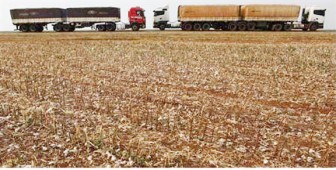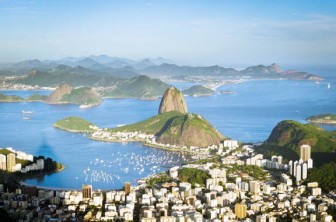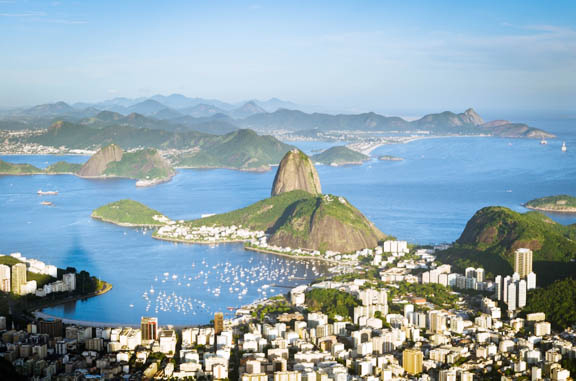RONDONOPOLIS, Brazil, (Reuters) – When Marcondes Mendonca hauls corn from Brazil’s farm belt to port in the distant south, the young trucker prays for protection from gaping potholes and dangerous drivers, and dreads the squalid toilets on the seven-day journey ahead.

He also braces for other hassles: traffic bottlenecks, backlogs at port and stifling bureaucracy that increasingly slow goods and services across Latin America’s largest country.
Overwhelmed infrastructure is one of the biggest challenges facing Brazil, the world’s sixth-biggest economy and a global breadbasket that could next year displace the United States as the world’s top soybean producer.
Transporters estimate road haulage rates will rise about 30 percent once the grains crop is harvested, with a shortage of drivers and new legislation that will keep trucks off the road for longer by requiring minimum rest periods for drivers.
To see the problems up close, a Reuters reporter and photographer hitched a ride with Mendonca on a recent journey. A 27-year-old father of two and fan of Brazilian country music, he hauls freight for a truckers’ collective and doubles as an instructor for aspiring drivers.

“May God protect us,” he said, above a hiss of the air brakes. Our 1,600 km (995 miles) stretch of his 2,100 km (1,300 miles) journey took us over broken asphalt, past points of deadly smashes, and on a nightly search for a rest stop with space for a last truck.
The trip, from the western farm state of Mato Grosso, across Brazil’s central savannah and southeast to the Atlantic port of Santos, highlighted rigors of the road familiar to truckers anywhere — long hours, loneliness and bad meals.
But it also made clear how Brazil’s ambition of supplying more of the world’s food is being hampered by inefficiency.
The cost of Mendonca’s haul amounted to nearly 40 percent of what the 37 tonnes of corn sold for in Santos. Transport across a similar distance in the United States, mostly by barge, amounts to only 10 percent of the price of U.S. corn at port.
Goods can also take three times as long to move a given distance as they do in China, a country that has used its run of economic success to invest heavily in roads, rail and ports.
“Logistics are jammed up,” says Glauber Silveira, head of Mato Grosso’s association of soy growers, who lose a quarter of their revenue to transport. “The buyer is losing out and the producer is losing out.”
With ample land, plentiful water, and high-tech farms cultivating its vast interior, Brazil is now the world’s biggest producer of sugar, coffee and citrus, the leading exporter of poultry and beef and on the verge of becoming the top soybean grower.
But the low-cost advantage that Brazil once enjoyed is succumbing to rising transport costs. The jaunt from farm to port in Brazil already costs more than twice the sea freight fees to China, and that ratio is about to climb sharply as wages rise and the laws on rest periods for drivers take effect.
The rising costs are forcing commodities traders to bid higher for Brazilian soy just to make sure growers keep planting. If prices approach costs, “it will seriously disincentivize Brazilian production,” said Kona Haque, an analyst at Macquarie Bank.
President Dilma Rousseff recently unveiled plans to lure $66 billion in private investment for roads, rail and other facilities. Deficient infrastructure is not only raising costs, it is prompting fears Brazil won’t be ready to host the 2014 World Cup soccer tournament and the 2016 Olympics, two events meant to showcase the country’s ascent.
OFF THE RAILS
The cabin of Mendonca’s Scania truck affords ample views of the chasm between Brazil’s first-world ambitions and the much humbler reality on the ground.
Reuters joined his journey on a Monday afternoon in Rondonopolis, a dusty logistics hub in southern Mato Grosso. By then, he had already driven three days north and back to load his two tarp-covered trailers now brimming with corn.
From there, we headed south. Rosary beads dangled from the windscreen, swinging with each bounce of the cabin.
Three hours in, we reached Alto Araguaia, a town where Mendonca’s journey could easily end. That’s where America Latina Logistica SA, a rail operator, runs the one link from the farm belt directly to Santos, the country’s biggest port.
The company’s 80-railcar trains haul as much corn as 230 two-trailer rigs like Mendonca’s, but burn the diesel of just 40 of them. High demand after the harvest, though, means the trains run full and at prices producers say don’t save much money.
Besides, the train takes just as long, with extended loading times at several terminals along the track and a steep decline near Santos port that has to be taken at crawling speed.
Brazil’s rail network, spanning 29,000 km (18,019 miles), is now smaller than it was 90 years ago.
As part of her infrastructure plans, Rousseff’s government is spending 22.4 billion reais ($11 billion) to build two major new rail lines that should help the farm belt. One stretches north-south, the other runs east-west.
Commodities firms say the investments can’t come soon enough. In a survey by the Fundao Dom Cabral business school of 126 large companies that churn out a quarter of Brazil’s GDP, the No. 1 proposed solution to cut freight costs was more rail.
Economists struggle to quantify the impact of Brazil’s infrastructure woes on the economy. But most agree that a poor transport network, saturated ports and other deficiencies prevent the economy from consistently growing more than 4 percent a year, a rate analysts say must be sustained over time for Brazil to attain developed nation status.
Most new rail projects are still five years away, or more.
So Mendonca drove on. Before midnight, we pulled into a rest stop. Mendonca slept on a mattress at the rear of the cabin. The reporter and photographer made do with a bench and a hammock.
On Tuesday, we headed for Mato Grosso’s southern border, a swooping toucan and cluster of ostrich-like rheas breaking the monotony of the flat terrain of brown, harvested fields.
LIFE ON THE ROAD
Mendonca passed the hours by telling his story. Born in nearby Goias state, his father and brother are also truckers. Itching to learn, he drove customers’ rigs around the yard at an uncle’s tire repair shop. “I had their permission,” he said.
In 2006, he moved to Rondonopolis and started work, earning about 3,000 reais ($1,500) a month. He put on 24 kg (53 pounds) in his first year at the wheel. He married.
The work is steady but trucking companies are struggling to find drivers. With unemployment near record lows, workers in Brazil have plenty of other, less demanding opportunities.
“There are no decent toilets or rest areas and so much dust everywhere,” complained Aguinaldo da Silva Tenorio, a 28-year-old trucker along the route. In the cab beside him were his wife, three-year-old daughter, and a month-old son. Taking them along, Tenorio said, is “the only option” for family time.
Truckers also complain of the dangers — occasional muggings and bad, congested roads. Driving across Mato Grosso do Sul, the next state down, Mendonca pointed to a spot where a drunk driver slammed into his cabin, killing the car driver’s girlfriend. “I can’t blame myself for something that wasn’t my fault,” he says.
Often, it’s fellow truckers that he worries about. In a rush to get to port – many are paid by the load – drivers make reckless efforts to pass. Many also take cocaine and an amphetamine derivative known as “rebite” to stay awake.
“When you’re sleepy, it sorts you out, but you can end up causing a huge mess,” says Ademir Pereira, a 36-year-old driver who admits to once popping the rebite pill.
Mendon?a says he never takes drugs to stay awake.
TIME AT THE WHEEL
More than 1,200 truckers died on Brazil’s federal highways last year, according to police data. To dissuade drug use and reduce the death toll, the government recently mandated rest periods for truckers for the first time.
Employed truckers who drive most of the truck miles covered in Brazil are now restricted to eight hours at the wheel per day, but self-employed truck owners can press on for 13.
On Tuesday night, we slept at another rest stop. At midday on Wednesday, Mendonca pulled into a restaurant in the north of Sao Paulo, the last state on the journey.
There, a worker said she sees benefits from the new law.
“Before, you would see truck drivers coming in with their eyes almost closed,” says Nilda Pereira Alves Pinto, who works the restaurant’s CB radio, touting its rice and beans over the airwaves. “They aren’t in such a rush anymore.”
Few disagree with the law’s aims, but some complain it makes it harder to meet demand and raises costs. “If they don’t let us drive overnight there won’t be enough trucks,” said Marcelo Galbati, a self-employed trucker waiting for a tire repair.
Rousseff’s plans include extending a farm-belt highway to a terminal on the Tapajos, an Amazon tributary that flows toward ports in the north. Despite boasting some of the world’s biggest rivers, little Brazilian freight sails.
The link will offer a route 900 km shorter to the Atlantic from 2014 but barge capacity will be limited by shallow waters.
On Wednesday evening, we bypassed Sao Paulo, South America’s biggest city, and the traffic thickened as trucks from across Brazil funnel onto the two highways to Santos, 80 km away.
The lack of rest areas was painfully clear. Mendonca paid a 150 reais toll for one highway but had to circle back and re-pay after leaving the road, only to find all rest stops were full. He’d gone beyond his legal driving time but had nowhere to stop.
At 2 a.m., as we descended through Atlantic rainforest, a wreck halted traffic. An hour later, we reached a rest stop.
“It’s looking ugly,” a gate attendant said, waving Mendonca in to try his luck for a parking spot to end a 20-hour day.
On Thursday morning, Mendonca waited for clearance to proceed to the Santos terminal just 20 km away where Archer Daniels Midland Co., the U.S. commodities trader, receives truckloads of grain and dispatches them on bulk carrier ships.
The port is infamous for red tape and is strained by rising cargo volumes. Not until 4 p.m. was the terminal ready for Mendonca. By then, though, unloading would mean leaving port late and another scramble for a rest stop, so he instead decided to sleep at the terminal’s waiting area.
It wasn’t until Friday morning, nearly seven days after he first left Rondonopolis, that Mendonca was finally able to pull up to a platform and offload, just yards from the docked bulk carrier ships filling with grain bound for other continents.
The corn’s value: $10,200. The cost of the haul: $3,800.

